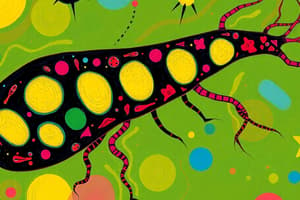Podcast
Questions and Answers
What is a primary reason that African Sleeping Sickness disproportionately affects rural populations in sub-Saharan Africa?
What is a primary reason that African Sleeping Sickness disproportionately affects rural populations in sub-Saharan Africa?
- Rural populations are more likely to consume bushmeat, which can be a source of trypanosome infection.
- Rural populations have less access to diagnostic testing, leading to delayed treatment and increased disease prevalence.
- Tsetse flies, the vectors of the disease, are predominantly found in rural areas where agriculture, fishing, and animal husbandry are common. (correct)
- Urban populations have better sanitation and hygiene practices, which prevent the spread of the trypanosome parasite.
Eradicating Tsetse flies would completely eliminate the risk of African Sleeping Sickness in humans and Nagana in animals.
Eradicating Tsetse flies would completely eliminate the risk of African Sleeping Sickness in humans and Nagana in animals.
False (B)
What factors, beyond the direct health impacts on humans, contribute to the significant economic burden associated with Nagana in Africa?
What factors, beyond the direct health impacts on humans, contribute to the significant economic burden associated with Nagana in Africa?
Reduced livestock productivity, trade restrictions, and decreased agricultural output
African Sleeping Sickness, caused by Trypanosoma brucei, is transmitted to humans via the bite of the ______ fly.
African Sleeping Sickness, caused by Trypanosoma brucei, is transmitted to humans via the bite of the ______ fly.
Match the following disease with its respective impact or characteristic:
Match the following disease with its respective impact or characteristic:
Which of the following mechanisms contributes to the unlimited potential of the VSG repertoire in trypanosomes?
Which of the following mechanisms contributes to the unlimited potential of the VSG repertoire in trypanosomes?
Trypanosomes evade the host immune system solely by preventing complement from accessing the plasma membrane.
Trypanosomes evade the host immune system solely by preventing complement from accessing the plasma membrane.
Describe how variant surface glycoprotein (VSG) provides a physical barrier that protects trypanosomes.
Describe how variant surface glycoprotein (VSG) provides a physical barrier that protects trypanosomes.
The differentiation of trypanosomes from slender to stumpy forms leads to ______ which contributes to waves of parasitemia.
The differentiation of trypanosomes from slender to stumpy forms leads to ______ which contributes to waves of parasitemia.
Match the following mechanisms of trypanosome immune evasion with their effects:
Match the following mechanisms of trypanosome immune evasion with their effects:
Which factor makes the development of a vaccine against trypanosomes particularly challenging?
Which factor makes the development of a vaccine against trypanosomes particularly challenging?
What is the primary role of hydrodynamic-flow mediated endocytosis in trypanosome immune evasion?
What is the primary role of hydrodynamic-flow mediated endocytosis in trypanosome immune evasion?
African Sleeping Sickness, caused by trypanosomes, is exclusively found in humans.
African Sleeping Sickness, caused by trypanosomes, is exclusively found in humans.
Considering the complex interplay between vector ecology, parasite biology, and host immunity in the context of Trypanosoma brucei infections, which strategy would MOST effectively contribute to sustained, long-term control of African trypanosomiasis, taking into account ecological impact and potential for resistance?
Considering the complex interplay between vector ecology, parasite biology, and host immunity in the context of Trypanosoma brucei infections, which strategy would MOST effectively contribute to sustained, long-term control of African trypanosomiasis, taking into account ecological impact and potential for resistance?
Given the limitations of current diagnostic methods for early-stage African trypanosomiasis and the need for accessible, field-deployable tools, which novel diagnostic approach holds the greatest promise for improving disease surveillance and control in resource-limited settings?
Given the limitations of current diagnostic methods for early-stage African trypanosomiasis and the need for accessible, field-deployable tools, which novel diagnostic approach holds the greatest promise for improving disease surveillance and control in resource-limited settings?
Considering the complex lifecycle of Trypanosoma brucei and its dependence on both the mammalian host and the tsetse fly vector, what evolutionary advantage is MOST likely conferred by the parasite's ability to undergo antigenic variation?
Considering the complex lifecycle of Trypanosoma brucei and its dependence on both the mammalian host and the tsetse fly vector, what evolutionary advantage is MOST likely conferred by the parasite's ability to undergo antigenic variation?
In the context of the economic burden imposed by Nagana on livestock agriculture in sub-Saharan Africa, which intervention strategy would provide the MOST sustainable and cost-effective solution for mitigating the disease's impact on rural livelihoods?
In the context of the economic burden imposed by Nagana on livestock agriculture in sub-Saharan Africa, which intervention strategy would provide the MOST sustainable and cost-effective solution for mitigating the disease's impact on rural livelihoods?
Given the observed geographical distribution of Trypanosoma brucei gambiense and Trypanosoma brucei rhodesiense, what environmental or socioeconomic factor MOST likely explains the lower incidence and slower progression of disease associated with T.b. gambiense compared to T.b. rhodesiense?
Given the observed geographical distribution of Trypanosoma brucei gambiense and Trypanosoma brucei rhodesiense, what environmental or socioeconomic factor MOST likely explains the lower incidence and slower progression of disease associated with T.b. gambiense compared to T.b. rhodesiense?
Considering the complexity of antigenic variation in Trypanosoma brucei, what is the most significant obstacle in developing a broadly effective vaccine?
Considering the complexity of antigenic variation in Trypanosoma brucei, what is the most significant obstacle in developing a broadly effective vaccine?
Given Trypanosoma brucei's reliance on variant surface glycoprotein (VSG) for immune evasion, what evolutionary pressure might explain the parasite's continued survival despite the host's ability to mount an antibody response?
Given Trypanosoma brucei's reliance on variant surface glycoprotein (VSG) for immune evasion, what evolutionary pressure might explain the parasite's continued survival despite the host's ability to mount an antibody response?
If a novel therapeutic agent were designed to disrupt VSG function specifically, which mechanism would represent the MOST DIRECT and EFFECTIVE means of compromising trypanosome survival in vivo?
If a novel therapeutic agent were designed to disrupt VSG function specifically, which mechanism would represent the MOST DIRECT and EFFECTIVE means of compromising trypanosome survival in vivo?
How does hydrodynamic-flow mediated endocytosis contribute to immune evasion?
How does hydrodynamic-flow mediated endocytosis contribute to immune evasion?
Consider a scenario where a novel drug inhibits the expression site switching mechanism in Trypanosoma brucei. What is the MOST LIKELY consequence of this drug on the parasite population within an infected host?
Consider a scenario where a novel drug inhibits the expression site switching mechanism in Trypanosoma brucei. What is the MOST LIKELY consequence of this drug on the parasite population within an infected host?
Which of the following reflects the MOST COMPLETE understanding of how VSG provides a physical barrier for trypanosomes?
Which of the following reflects the MOST COMPLETE understanding of how VSG provides a physical barrier for trypanosomes?
In a strain of Trypanosoma brucei with a genetically modified VSG repertoire limited to a single VSG gene, what would be the most probable outcome in a mammalian host?
In a strain of Trypanosoma brucei with a genetically modified VSG repertoire limited to a single VSG gene, what would be the most probable outcome in a mammalian host?
If a mutation arose in Trypanosoma brucei that completely abolished the ability to differentiate into stumpy forms, what would be the MOST LIKELY consequence on disease transmission and progression?
If a mutation arose in Trypanosoma brucei that completely abolished the ability to differentiate into stumpy forms, what would be the MOST LIKELY consequence on disease transmission and progression?
Flashcards
Trypanosoma brucei
Trypanosoma brucei
A unicellular, extracellular parasite transmitted by Tsetse flies, causing sleeping sickness in humans and Nagana in animals.
Sleeping sickness
Sleeping sickness
Fatal disease in humans caused by Trypanosoma brucei, with ~1,000 cases/year.
Nagana
Nagana
Disease in animals (especially cattle) caused by Trypanosoma brucei, leading to significant economic losses in Africa.
Tsetse fly
Tsetse fly
Signup and view all the flashcards
HAT
HAT
Signup and view all the flashcards
Rhodesiense Cases
Rhodesiense Cases
Signup and view all the flashcards
Mosaic Formation
Mosaic Formation
Signup and view all the flashcards
Waves of Parasitemia
Waves of Parasitemia
Signup and view all the flashcards
Trypanosome Immune Evasion
Trypanosome Immune Evasion
Signup and view all the flashcards
VSG Protective Barrier
VSG Protective Barrier
Signup and view all the flashcards
Antigenic Variation
Antigenic Variation
Signup and view all the flashcards
Trypanosome Disease
Trypanosome Disease
Signup and view all the flashcards
Trypanosome Hosts
Trypanosome Hosts
Signup and view all the flashcards
African Sleeping Sickness
African Sleeping Sickness
Signup and view all the flashcards
Disease Distribution (HAT)
Disease Distribution (HAT)
Signup and view all the flashcards
Populations at Risk (HAT)
Populations at Risk (HAT)
Signup and view all the flashcards
VSG Shielding
VSG Shielding
Signup and view all the flashcards
Hydrodynamic-flow mediated endocytosis
Hydrodynamic-flow mediated endocytosis
Signup and view all the flashcards
Expression Site Switching
Expression Site Switching
Signup and view all the flashcards
VSG Insertion
VSG Insertion
Signup and view all the flashcards
VSG Repertoire
VSG Repertoire
Signup and view all the flashcards
Slender Form
Slender Form
Signup and view all the flashcards
Slender to Stumpy Differentiation
Slender to Stumpy Differentiation
Signup and view all the flashcards
Study Notes
- Trypanosomes express a single VSG "isotype" at one time
- It is eventually overwhelmed by antibody response
Immune Evasion in detail
- Extracellular parasites are vulnerable to antibodies, complement, and immune cells, yet still can thrive in the same host for a year or longer
- Variant Surface Glycoprotein (VSG) surrounds the cell
- Has 1 x 10^7 densely packed VSG per cell (approximately 10% of total cellular protein)
- Shields other proteins from detection by antibodies
- Shields the membrane by preventing complement
- VSG-bound antibodies are 'swept' to the posterior of the cell by hydrodynamic flow, which is essential for host infection and relies on trypanosome motility
- Antigenic Variation allows the cell to change the VSG isotype that is expressed
- Including Expression site switching
- Inserting a different VSG into the expression site
- And Making entirely new, mosaic VSGs
- Due to Trypanosome immune evasion, a vaccine is unlikely
Summary 1
- Trypanosomes cause African Sleeping Sickness, a neglected tropical disease
- Trypanosomes infect mammals and are transmitted by tsetse in sub-Saharan Africa
- These extracellular parasites can survive for years in the bloodstream
- Trypanosomes have evolved mechanisms to overcome the host immune system
Summary 2
- The characteristic 'waves of parasitaemia' observed in a chronic infection are explained by these key features:
- Slender form proliferation
- Slender to stumpy differentiation
- Parasite death caused by anti-VSG antibodies (when hydrodynamic flow is overwhelmed)
- Antigenic variation
Studying That Suits You
Use AI to generate personalized quizzes and flashcards to suit your learning preferences.




